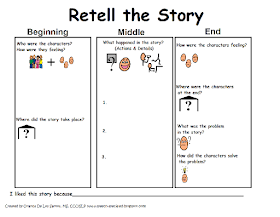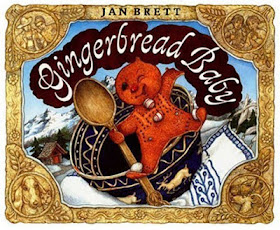Because I work with such a diverse population of students and cultural backgrounds, I really have to focus on choosing diverse activities that allow us to celebrate the season in many different ways. My favorite book to read this time of year is "The Gingerbread Man". It's a fun story about something that we all enjoy: COOKIES! This year, I have collected MANY versions of this story to enjoy with my students!
The goals that I target during these activities include the following:
Articulation/phonology: multi-syllable words/phrases; final consonants; phonemes: "dge", /f/, /k/
Receptive language: Recognizing animals, actions, positions
Expressive Language: Core Vocabulary--"In, Out, Go, Run, He, She, They"; Answer Who, What Doing, Where and Why Questions; Problem solving; Inference; Predicting; Story Grammar; Sequence; Re-telling stories, Compare/Contrast
Pragmatic Language: Feelings/emotions, Non-literal language/Metaphors ("Sly as a Fox")
I started by reading this version: "The Gingerbread Man". In this version, the fox tricks the gingerbread man by telling him, "Come closer, I can't hear you". The kids love this one because we all YELL together like the gingerbread man, "I have run away from . . . .!" and then we list all of the characters.
Then I read this version of the book:
I talked to the students about "folk tales" and why there are different versions of this story. The second version of the story has more details about the process for making gingerbread and has new vocabulary like "sugary glaze". This version also has different characters from the first version of the story.
While reading each story, we focused on the articulation and phonology goals using the repetitive text "Run, Run as fast as you can, you can't catch me, I'm the gingerbread man!" Then, after reading each story (usually during the second session), we retold the story using this visual that I created: Retell the Story. This is a great tool that we used to identify the Story Parts and practice Sequence skills. This is also helpful for identifying details and events from the a story.
After retelling each version of the story. We were worked on compare/contrast of the stories. I use a simple Venn diagram to compare/contrast the stories. I found a new idea on how to do this on Pinterest using paper plates. What a great idea! Here is the link to the post: Paper Plate Venn Diagrams
The kids have been so engaged that I sought out many more versions of this story and have them laid out. They ask every day which book we will read next! So, we also read these stories and completed the same kinds of activities. Here they are:
The kids have done such a great job and have been really engaged in pointing out similarities and differences while we have read the books. I have been using these activities with Pre-K through 2nd grade students. I even used the first version of this story in my youngest pre-school group. I found lots of Gingerbread Man activities on various websites, here are some of my favorites!
Sequence pictures and a mini book:
Gingerbread Man themed games and websites:
YouTube Links for Gingerbread Man story and How to Make Gingerbread cookies:
I really like the video "Gingerbread Men Recipe Demonstration". It's kind of long, so I fast-forwarded many parts, but it was great for my students to see the process for making gingerbread cookies. Many of them thought that decorating and eating were the only steps! The last activity that I did with the kids was to make cookies with them. I had them list the steps for making the cookies and I purchased some Gingerbread Cookie Mix. We did this hands on activity to complete the recipe, bake the cookies, decorate, and EAT (everyone's favorite).
If you have students with diet restrictions or have limitations in making real cookies, we also had lots of fun using the Cookie Doodle app on the iPad. Using this app, you and your students can walk through the steps of mixing the ingredients, baking, and decorating. It's fun, too!
I hope you have fun using some of these Simple Speech "holiday themed" activities with your students! What are your favorite books or activities to use during the holiday season?
~Orlanda
























































